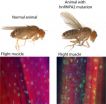(Press-News.org) ENERGY – Reducing biorefinery waste . . .
By introducing microbial fuel cells into the corn stover biorefinery waste recovery process, a team of researchers at Oak Ridge National Laboratory has demonstrated a new way to produce bioenergy from the process waste stream. The process developed by ORNL's Abhijeet Borole and colleagues from the University of Tennessee and National Renewable Energy Laboratory provides a direct alternative to generate electricity compared to a mature but multi-step path that uses anaerobic digestion. Major advantages of the ORNL method include the ability to convert organics, which are difficult to degrade, into electricity or hydrogen. In addition the changes can lead to reductions in the amount of fresh water required in the process and the potential to handle high concentrations of ammonia. Details of the study are available in the paper, titled "Conversion of Residual Organics in Corn Stover-Derived Biorefinery Stream to Bioenergy via a Microbial Fuel Cell," published in Environmental Science & Technology. [Contact: Ron Walli, (865) 576-0226; wallira@ornl.gov]
HEALTH – Faster vitamin analysis . . .
Quantitative analyses of vitamins can be done in minutes with minimal processing, saving time and money with a technique successfully demonstrated by a team of Oak Ridge National Laboratory researchers. Ensuring that food and dietary supplements have the prescribed amount of ascorbic and folic acids is of critical importance because excessive amounts of these vitamins can have a detrimental effect. Using a process called flow-injection tandem mass spectrometry, Gary Van Berkel and colleagues demonstrated results that were in agreement with liquid chromatography-based results obtained by National Institute of Standards and Technology methods. The findings were published recently as a research article in Rapid Communications in Mass Spectrometry. [Contact: Ron Walli, (865) 576-0226; wallira@ornl.gov]
CLIMATE – Recreating the past . . .
About 22,000 years ago the Earth's great ice sheets began to decline, bringing an end to the Last Glacial Maximum. Given the growing concerns about today's shrinking glaciers and polar ice caps, scientists are interested in knowing what happened the last time the Earth shed much of its ice. Now a group of researchers has run simulations on an Oak Ridge National Laboratory supercomputer over three years to create the first physics-based test of hemispheric deglaciation. Their culprit: a combination of increased insolation (solar radiation that reaches the earth's surface) caused by changes in the Earth's orbit, and ocean circulation. Their work was published in the Feb. 7 issue of Nature. [Contact: Scott Jones, (865) 574-6944; jones@ornl.gov]
LIGHTING – Brighter future for LEDs . . .
Lights at the Superdome could have been back on in minutes with an LED system developed by an Oak Ridge company that's using Oak Ridge National Laboratory technology. In 2010, LED North America licensed an application for graphite foam, which passively cools components in light-emitting diode lamps. This technology is being used in LED North America's patent-pending module, eliminating most of the weight associated with traditional luminaires that incorporate high-power LEDs. The company has now expanded the concept, enabling an array of modules to be bundled. The lights are already being used in a high-bay application at a facility that handles logistics for Nissan as well as other indoor commercial warehouse buildings. These lights, which use less energy, could potentially replace the mercury lamps used at arenas and stadiums around the country, including the Superdome, which during Super Bowl XLVII experienced a power outage that knocked out many of the lights for half an hour. [Contact: Ron Walli, (865) 576-0226; wallira@ornl.gov]
ENVIRONMENT – Better hydrogen trap . . .
With the development of a new method to trap hydrogen in clathrate hydrates, which are ice-like structures, Oak Ridge National Laboratory researchers have made a discovery that could have broad implications for hydrogen storage and astrophysics. For years, scientists have recognized that these hydrate structures would be an ideal storage medium for hydrogen if it weren't for the high-pressure requirement, which makes it too costly for industrial applications. Now, scientists at the Spallation Neutron Source have demonstrated a way to trap hydrogen in clathrate structures at much lower pressures, perhaps providing a path forward for storage of greenhouse gases and understanding the nature of matter in deep space science. [Contact: Agatha Bardoel, (865) 574-0644; bardoelaa@ornl.gov]
### END
March story tips
2013-03-04
ELSE PRESS RELEASES FROM THIS DATE:
Toddler 'functionally cured' of HIV infection, NIH-supported investigators report
2013-03-04
A two-year-old child born with HIV infection and treated with antiretroviral drugs beginning in the first days of life no longer has detectable levels of virus using conventional testing despite not taking HIV medication for 10 months, according to findings presented today at the Conference on Retroviruses and Opportunistic Infections (CROI) in Atlanta.
This is the first well-documented case of an HIV-infected child who appears to have been functionally cured of HIV infection—that is, without detectable levels of virus and no signs of disease in the absence of antiretroviral ...
A billion deaths from tobacco are a key obstacle to global development
2013-03-04
If the word's nations are going to prevent tobacco smoking from causing one projected billion deaths by the end of this century, they must:
Make tobacco control part of the agendas of United Nation's and other development agencies worldwide;
Assure every sector of a nation including health, trade and finance officials work collectively to protect not only health but the harm tobacco places on their economy by passing laws to reduce use;
Place health as the centerpiece of any decision on a trade treaty that includes tobacco;
Diligently work toward a goal of reducing ...
Was King Richard III a control freak?
2013-03-04
University of Leicester psychologists have made an analysis of Richard III's character – aiming to get to the man behind the bones.
Professor Mark Lansdale, Head of the University's School of Psychology, and forensic psychologist Dr Julian Boon have put together a psychological analysis of Richard III based on the consensus among historians relating to Richard's experiences and actions.
They found that, while there was no evidence for Shakespeare's depiction of Richard III as a psychopath, he may have had "intolerance to uncertainty syndrome" – which may have manifested ...
International aid and advocacy groups are influenced by their home countries' cultures
2013-03-04
In February, Greenpeace activist and actress Lucy Lawless, star of "Xena: Warrior Princess," was sentenced to 120 hours of community service for boarding a Shell oil rig to protest offshore Arctic drilling. Dramatic protests by Netherlands-based Greenpeace contrast sharply with the lobbying and letter-writing of the U.S.-based Sierra Club. The differences among those two groups and other international non-governmental organizations (INGOs) reflect the cultures of the nations where they are based, according to research by a University of Missouri political scientist. Individuals ...
Vortex loops could untie knotty physics problems
2013-03-04
University of Chicago physicists have succeeding in creating a vortex knot—a feat akin to tying a smoke ring into a knot. Linked and knotted vortex loops have existed in theory for more than a century, but creating them in the laboratory had previously eluded scientists.
Vortex knots should, in principle, be persistent, stable phenomena. "The unexpected thing is that they're not," said Dustin Kleckner, a postdoctoral scientist at UChicago's James Franck Institute. "They seem to break up in a particular way. They stretch themselves, which is a weird behavior."
This behavior ...
Solutions Real Estate's Massive Success and Continued Growth is the Hottest Topic in San Diego Real Estate News Today
2013-03-04
Matt Johnson fell in love with San Diego in 1998, and has resided here ever since.
He is familiar with the local neighborhoods inside and out, and has the ability to assist you in selecting the best one for your family's needs.
Matt got his start in real estate at the age of 9, helping his Dad turn dilapidated old houses into the gem of the neighborhood. He later continued on that tradition, becoming a professional home renovator with operations in two states. Several years later, he realized his passion was in the sales and marketing side, so he obtained his license ...
Researchers discover how to shutdown cancer's powerful master protein
2013-03-04
NEW YORK (March 3, 2013) -- The powerful master regulatory transcription factor called Bcl6 is key to the survival of a majority of aggressive lymphomas, which arise from the B-cells of the immune system. The protein has long been considered too complex to target with a drug since it is also crucial to the healthy functioning of many immune cells in the body, not just B cells gone bad.
But now, in the journal Nature Immunology, researchers at Weill Cornell Medical College report that it is possible to shut down Bcl6 in the cancer, known as diffuse large B-cell lymphoma ...
7 genetic risk factors found to be associated with common eye disorder
2013-03-04
An international group of researchers has discovered seven new regions of the human genome—called loci—that are associated with increased risk of age-related macular degeneration (AMD), a leading cause of blindness. The AMD Gene Consortium, a network of international investigators representing 18 research groups, also confirmed 12 loci identified in previous studies. The findings are reported online today in the journal Nature Genetics. Supported by the National Eye Institute (NEI), a part of the National Institutes of Health, the study represents the most comprehensive ...
Scientists identify 'clean-up' snafu that kills brain cells in Parkinson's disease
2013-03-04
March 3, 2013— (Bronx, NY) — Researchers at Albert Einstein College of Medicine of Yeshiva University have discovered how the most common genetic mutations in familial Parkinson's disease damage brain cells. The study, which published online today in the journal Nature Neuroscience, could also open up treatment possibilities for both familial Parkinson's and the more common form of Parkinson's that is not inherited.
Parkinson's disease is a gradually progressing disorder of the nervous system that causes stiffness or slowing of movement. According to the Parkinson's ...
Adding to the list of disease-causing proteins in brain disorders
2013-03-04
PHILADELPHIA – A multi-institution group of researchers has found new candidate disease proteins for neurodegenerative disorders. James Shorter, Ph.D., assistant professor of Biochemistry and Biophysics at the Perelman School of Medicine, University of Pennsylvania, Paul Taylor, M.D., PhD, St. Jude Children's Research Hospital, and colleagues describe in an advanced online publication of Nature that mutations in prion-like segments of two RNA-binding proteins are associated with a rare inherited degeneration disorder affecting muscle, brain, motor neurons and bone (called ...


